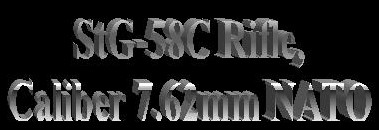CRUFFLER.COM
presents
FIREARM
REVIEW,
February
2000:
 |
 |
 |
 |
Type:
Self Loading Rifle
System of Operation: Gas Caliber: 7.62mm NATO Capacity: 20 round box magazine Sights, front: Elevation adjustable front post Sights, rear, fully adjustable aperture Length: OAL 43", Barrel 21" Weight: 10.8 lbs Suggested Retail Price: $950.00 |
One of the largest, if not the largest, markets in the world for surplus military firearms is the United States. It should come as no surprise then that most, if not all, of the surplussed StG58's ended up in the United States. Due to restrictions on the ownership of fully automatic firearms, however, these rifles entered the country as "parts kits," without the upper receiver that permits installation of the automatic firing mechanism. The market for military style self loading rifles being what it is, several businesses in the United States were soon producing FAL upper receivers modified so as to permit only semiautomatic fire. Two of these companies, Entreprise Arms, and DS Arms, offer an StG58 parts kit assembled onto a domestically produced semiautomatic receiver.
PRODUCT
REVIEW
CRUFFLER.COM
has long had an love affair with the FAL. Since we had access to
an actual military FAL, we decided to obtain one of the semiautomatic versions
currently on the market so as to make a comparison. To do so, we
contacted Inter Ordnance of America,
of Monroe, North Carolina and placed an order for an STG58C. Inter
Ordnance is the importer of the majority of the StG58 parts sets that enter
the United States. Once the parts sets are imported, they are sent
to
Entreprise Arms of Irwindale,
California, for assembly onto an Entreprise Arms Type 03 Metric FAL receiver.
| During assembly, Entreprise Arms replaces some of the original Austrian parts with domestically produced parts so that the completed rifles will qualify as domestically produced firearms under US federal regulations. These parts are internal and include the hammer, gas piston, and magazine spring and floorplate. They do not function any differently than the originals. Also replaced due to federal regulation is the original flash suppressor, a long heavy affair that also permitted the StG58 to launch grenades and cut barbed wire. The replacement part is a nicely executed muzzle brake that is similar in length, and slightly smaller in external diameter than the flash suppressor /grenade launcher found on Fabrique |
dimensions. They are better refered to as "European and Commonwealth" patterns, as Australia, Britain, Canada (ABC or Commonwealth - New Zealand and New Guinea and a few others, too, BTW) use one set of componants and the other countries use the European pattern. Complete assemblies are interchangable, as well as most small parts, but parts within the assemblies are not interchangeable. For examble, a complete metric bolt and carrier will fit in either gun, but extractor springs are different. A complete lower can be used on any gun, but the pin diameters for the trigger and hammer are different. The only true metric pattern gun is the Israeli FAL, which is somewhat unique, although again, complete assemblies can we swapped. When reading about
commercially available FAL receivers, one often hears them classed as either
Type 03 or Type 01. A Type 01 receiver is the original metric pattern
with weight reducing cuts inside and outside the receiver. A Type
02 has a reinforced area at the rear of the receiver that is not "lightened"
while a Type 03 has no lightening cuts.
|
Two days after we placed the order, the BBT (that's Big Brown Truck - UPS to the non-crufflers among you) showed up with a large rifle box. The rifle was well packed in a proprietary box, being held in place by cardboard baffles. It came with one twenty round magazine, a sling, muzzle cover, an Austrian military cleaning kit, and a magazine pouch. Upon inspection, however, some rather disappointing faults were noted. While these faults were cosmetic and not functional in nature, they were unacceptable to us for what was billed as a "new" rifle. There were blotchy discolorations on the lower receiver as if oil had not been cleaned off when the gun was parkerized; there was a welding flux drip down the underside of the barrel from the muzzle brake installation; there was rust at the seam between the rear of the muzzle brake and the barrel; and there was a gap, sufficiently large to see daylight through, between the lower receiver and the buttstock. And so, it went back to Inter Ordnance the same day.
Now, it's our considered opinion that everyone can have a bad day, and that firearm manufacturers and distributors are no exception to this rule. Consequently, whenever something like this happens, we make it a point to give the seller an opportunity to make it right. To date our ratio of positive to negative results is about 15:1. The results in this case were no exception to the rule. Inter Ordnance's owner, Uli Wiegand, got personally involved without any special request or demand on our part, and a new rifle was overnighted to us the morning after the rifle we had returned arrived back at
|
As an aside, we at CRUFFLER.COM were and are quite happy with the aesthetic qualities of the Entreprise Arms receiver - but applaud Mr. Weigand's decision to attempt to produce a higher quality product for the same price. We anticipate that any quality control issues will be minimized by this transition. |
Inter
Ordnance. The rifle we received in exchange was as perfect as we could
have hoped for, and more than made up for the shortcomings of the first
gun.
Our first order of business was to conduct a detailed and thorough visual examination. The finish is a uniform grey parkerizing (done when the rifle was assembled onto the Entreprise Arms receiver) with the exception of the plastic buttstock and pistol grip (the StG58 was made with |
The
Headspace Debacle
Next,
we checked the rifle's headspace using a set of Sporting Arms and Ammunition
Manufacturer's Institute (SAAMI) .308 Winchester headspace gauges (1.630"
GO, 1.634" NO-GO, and 1.640" FIELD). Before we go any further with
this discussion there are some points that need to be addressed:
| 1. | The .308 Winchester and the 7.62mm NATO cartridges are not the same, nor are they interchangeable despite similarities in external dimensions. The 7.62mm NATO cartridge has a maximum chamber pressure of approximately 50,000 pounds per square inch, the .308 Winchester has a maximum chamber pressure of approximately 66,000 pounds per square inch. This is not to say that all .308 Winchester loads will develop such pressures, merely that they may, and would be within manufacturing tolerances if they did so. Consequently, CRUFFLER.COM strongly recommends against ever firing .308 Winchester ammunition in a firearm chambered for the 7.62mm NATO. Doing so risks damage to the firearm and injury to the shooter. |
| 2. | The FAL, and by extension, the STG58C, are chambered for the 7.62mm NATO and not the .308 Winchester. |
|
|
Headspace
dimensions for the FAL rifle are as follows:
Minimum: 1.6315"Take note that there are no "GO," "NO-GO," or "FIELD" dimensions - in this case, these nomenclatures apply only to COMMERCIAL rifles chambered for the .308 Winchester. |
That being said, the results from the headspace gauging were as follows: The bolt closed easily on the 1.630" "GO" gauge, closed with a hint of resistance on the 1.634" "NO-GO" gauge, and didn't even come close to closing on a 1.640" "FIELD" gauge. Our conclusion from these tests is that our STG58C rifle is perfectly within specification for an "in service" FAL, and probably for a new, fresh out of the factory, FAL, and is ready to digest many rounds of 7.62mm NATO ammunition.
Remember, the designers of the FAL, and military rifles in general anticipated that these firearms would be fed a steady diet of one or two very specific types of virgin (non-reloaded) ammunition made to very specific standards. Deviation from that norm would, at the least, be suboptimal, and could result in damage or injury. Given the abundance of inexpensive military surplus 7.62mm NATO ammunition available today, shooters have no reason to resort to shooting .308 Winchester in military rifles like the FAL or their commercial analogs like the STG58C.
Now that the STG58C had passed a visual and headspace inspection with flying colors, it was time to take it to the range for the acid test.
Shooting
the STG58C
Before
shooting the STG58C, we disassembled it for a thorough cleaning.
It was less than thrilling to find that the innards of the rifle, to include
the bore, were filthy from powder and carbon residue left from the factory
test firing. It's hard to fault Entreprise Arms for this, though,
as it seems to be an industry trend as evidenced by "new in the box" firearms
we have received from Smith & Wesson, Colt, Glock, SIG-Sauer, and CZ,
to name a few. After about 40 minutes and 45 patches, the gun and
the bore were about as clean as they were going to get. After cleaning,
the rifle was reassembled, and the reciprocating parts (bolt carrier group)
lightly greased.
Ammunition
Around
lunchtime the next day, we trundled off to the NRA indoor range, located
at the NRA headquarters in Fairfax, Virginia. The 7.62mm NATO ammunition
we planned to use was of four types: Portuguese military production
bearing the NATO cross-in-circle symbol on the headstamp, British military
ammunition by both Kynoch and Radway Green, both of which bore the NATO
symbol, and Argentine military ammunition which did not have the NATO symbol.
All ammunition was factory loaded with military 147 +/- grain full metal
jacket spitzer projectiles.
Gas System
Tuning
The
first order of business was to tune the gas system. The FAL has an
adjustable gas regulator that allows the shooter to "tune" just how much
or how little gas enters the operating system, so as to minimize recoil
and battering of the reciprocating parts. Tuning the gas system is
done to adjust for things such as the rifle's getting progressively dirtier
or changes in ammunition. There are 15 settings on the STG58C, starting
at 1, and going to 1.5, 2. . . . . .7.5. At setting 1, the gas regulator
is completely shut, allowing the maximum amount of gas to enter and work
upon the mechanism, and at 7.5 it is completely open, allowing a minimal
amount of gas into the mechanism. We found that with the NATO marked
ammunition, the rifle would function well with the regulator set at 5,
while the Argentine ammunition required more gas to operate upon the system,
necessitating a setting of 2.5 for reliable operation.
Accuracy
After
tuning the gas system, we fired the rifle for accuracy. Shots were
fired at the maximum range of 50 yards, from a rested position on the bench.
We fired twenty rounds (one magazine) in groups of five shots to zero the
rifle. The first string was low and to the right. By the fourth
string we were shooting centered and in the black. Sight adjustment
was easy and positive with no "slop" in the detents or tensioning screws.
The next magazine was fired for accuracy. Not counting a few shots
that were identified as shooter error, these rounds were all in a little
1" high by 2" wide cluster centered in the upper half of the target's ten
ring. Put another way, we are well satisfied that the STG58C is capable
of far better accuracy than we are!
Recoil
Felt
recoil was extremely light, making the STG58C a very pleasant rifle to
shoot. We attribute this light recoil in large part to the
highly effective muzzle brake that is installed in place of the original
flash suppressor/grenade launcher device. In fact, recoil was very
significantly reduced from the levels experienced with a military FAL using
only a flash suppressor, or other self loading rifles chambered for the
7.62mm NATO such as the M1A or HK91. Even shooters who are particularly
sensitive to recoil will find the STG58C a pleasant rifle to shoot.
Reliability
The
only failures to feed or stoppages were directly attributable to operator
error in failing to adjust the gas regulator for varying ammunition types.
It is anticipated that as the rifle wears in, and the reciprocating parts
shed some of their parkerizing along their mating surfaces, the rifle will
only become more reliable. Fired cases were inspected for signs of
excessive headspace, or any other irregularities. None were found.
The only issue with fired cases were that some of the case mouths were
dented upon ejection.
Comparison
Firings
Also
fired, for comparison's sake were a military FAL and a rifle assembled
from an StG58 parts kit onto a DS Arms receiver. All three rifles
were on par as far as accuracy and reliability were concerned.
However, the military FAL had a much harder, more intense recoil that made
the rifle significantly less pleasant to shoot.
CONCLUSION
In conclusion,
the STG58C is well made and a pleasure to shoot. If you are in the
market for a military style self loading rifle, this gun represents one
of the best values out there. Based on our experience, we cannot
recommend it highly enough. If you have any questions about where
and how to go about acquiring an STG58C, please contact CRUFFLER.COM.
And now,
our Buy-O-Meter rating for this product:
 |